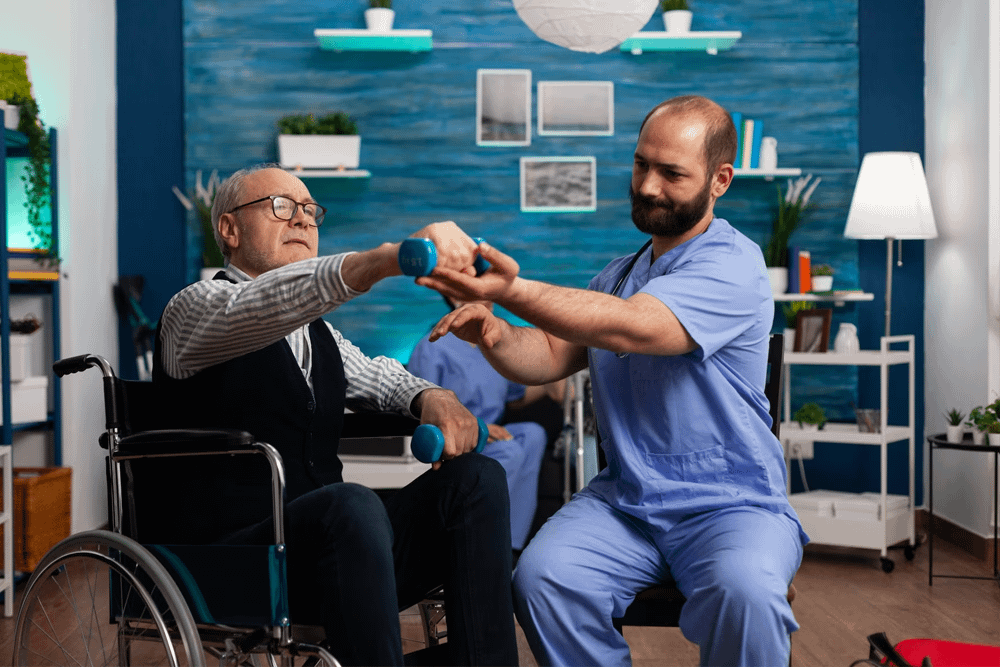Orthopedic surgery enables patients to regain their mobility and quality of life. However, the journey to full recovery doesn’t end in the operating room. It requires a comprehensive rehabilitation plan and the guidance of skilled physical therapists. In this Blog, we’ll understand the importance of rehabilitation and physical therapy after surgery.
Patients must seek the best orthopedic surgeon in Chandigarh for their particular situation. Once the surgery has been completed, it is equally important to go through a careful rehabilitation and physical therapy program to ensure a full and healthy recovery.
Recovering from Orthopedic Surgery: Tips and Strategies:
With the help of a skilled orthopedic surgeon in Chandigarh, patients can be given the best treatment and guidance to aid their recovery. Physical therapy exercises after surgery are crucial for helping regain joint movement and muscle strength. In contrast, physical therapy for joint replacement is important for helping with a range of motion and overall muscle function. By following these tips and strategies, patients can recover fully.
Myths about Physiotherapy:
Myth 1- Physiotherapy is not necessary after joint replacement surgery
Actual Fact – Physiotherapy is an essential component of the recovery process after joint replacement surgery. It helps restore mobility, strength, and joint function, reduces pain and swelling, and improves overall outcomes. Physiotherapy is vital in optimizing recovery and ensuring a successful return to daily activities.
Myth 2 – Physiotherapy is only required for a short period after surgery.
Actual Fact – While the duration of physiotherapy may vary depending on individual factors, it is not limited to just the immediate postoperative period. Physiotherapy may continue for several weeks or months after surgery to support the healing process, regain strength and range of motion, and gradually return to full functional capacity. The duration and frequency of physiotherapy sessions are determined based on the patient’s progress and specific needs.
Myth 3 – Physiotherapy after joint replacement surgery is painful and uncomfortable.
Actual Fact – Physiotherapy after joint replacement surgery is carefully tailored to each patient’s pain tolerance and comfort level. Physiotherapists use techniques and modalities that help manage pain and discomfort during the rehabilitation process. While some exercises or stretches may cause temporary discomfort, physiotherapists work closely with patients to ensure that the intensity and progression of exercises are appropriate and manageable.
Myth 4 – Physiotherapy is only for people with severe joint pain or mobility issues.
Actual Fact – Physiotherapy is not solely reserved for individuals with severe joint pain or mobility issues. It benefits patients undergoing joint replacement surgery at any stage of their condition. Physiotherapy helps optimize outcomes, promote faster recovery, and enhance overall function and mobility, regardless of the initial severity of symptoms. It can benefit patients with various joint conditions, such as osteoarthritis, rheumatoid arthritis, or joint injuries.
Myth 5 – Physiotherapy is not effective; joint replacement surgery alone is sufficient.
Actual Fact – Joint replacement surgery replaces the damaged joint with an artificial implant, but physiotherapy is crucial for optimizing the surgical outcomes. Physiotherapy is vital in reducing pain, restoring range of motion, strengthening muscles, improving balance and coordination, and facilitating a safe return to daily activities. Combining surgery and physiotherapy leads to better functional outcomes and a higher quality of life for patients.
Advantages of Physiotherapy in Joint Replacement Surgery:
Physical therapy is an integral part of orthopedic surgery recovery:
Restore Range of Motion:
After the surgery, joints, and muscles may become stiff and lose their normal range of motion. Physical therapists employ various techniques, such as stretching exercises, manual therapy, and joint mobilizations, to gradually restore flexibility and mobility to the affected area.
Strengthening Muscles:
Surgery often leads to muscle weakness due to limited activity during the recovery period. Physical therapists develop specific exercise programs to target weakened muscles and rebuild their strength. These exercises may include resistance training, weight-bearing exercises, and functional movements tailored to the patient’s needs.
Enhancing Balance and Coordination:
After orthopedic surgery, individuals may experience difficulties with balance and coordination due to muscle weakness, joint instability, or changes in proprioception. Physical therapists incorporate exercises and activities that challenge balance and coordination to improve functional abilities and reduce the risk of falls.
Pain Management:
Orthopedic surgery can cause post-operative pain and discomfort. Physical therapists use pain management techniques, such as heat or cold therapy, electrical stimulation, ultrasound, and manual techniques, to help alleviate pain and promote healing.
Balance and Coordination:
Joint replacements can temporarily affect balance and coordination. Rehabilitation programs incorporate exercises and activities that challenge balance and coordination, improving stability and reducing the risk of falls. This may include balance exercises, proprioceptive training, and functional movements.
The Role of Physical Therapy in Joint Replacement:
Joint replacement surgery, such as hip or knee replacement, requires the storage of the specialized rehabilitation approach. This part will focus on the unique challenges and goals of physical therapy following joint replacement, including weight-bearing exercises, gait training, and regaining joint stability. Additionally, it will discuss how physical therapy optimizes the lifespan and functionality of the artificial joint.
Conclusion:
Rehabilitation and physical therapy are vital to the recovery process after orthopedic surgery. By working closely with the best orthopedic surgeon in Chandigarh and following a tailored physical therapy plan, patients can optimize their outcomes, regain strength and mobility, and return to their normal lives with increased confidence. Remember, patience and dedication are key, and the guidance of skilled professionals can make all the difference in the journey to a successful recovery.



